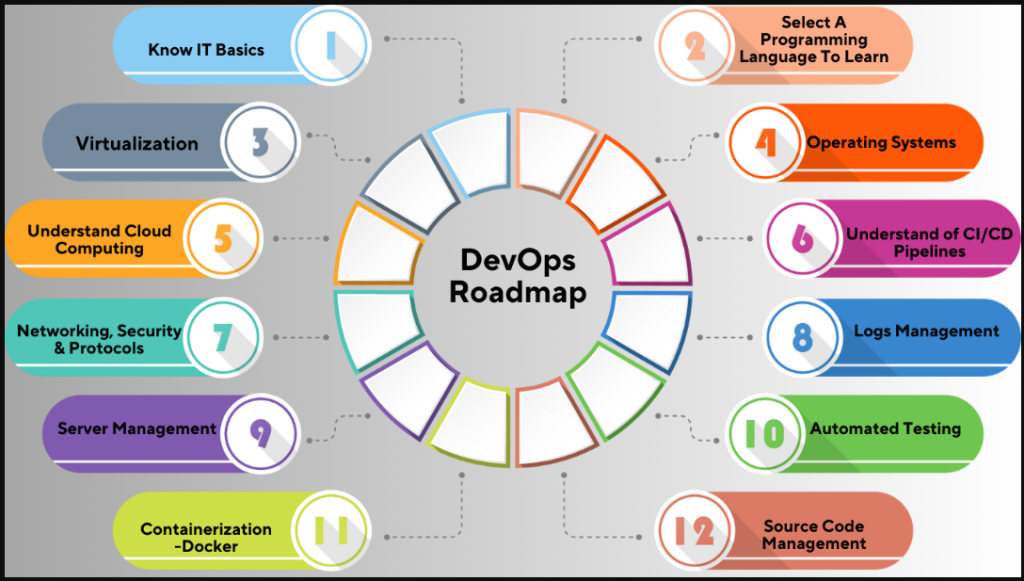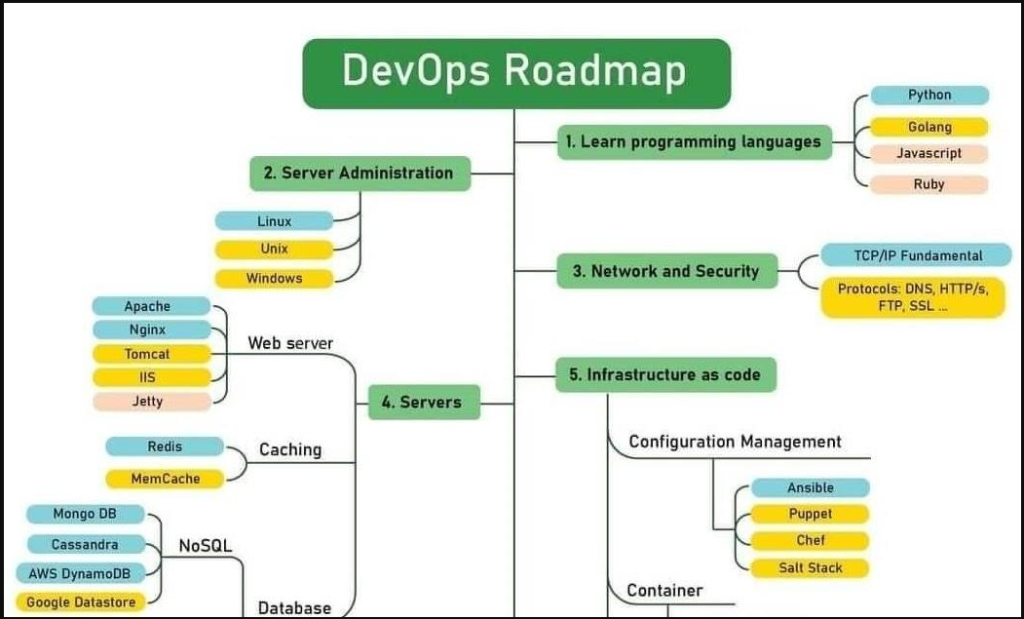Upgrade & Secure Your Future with DevOps, SRE, DevSecOps, MLOps!
We spend hours on Instagram and YouTube and waste money on coffee and fast food, but won’t spend 30 minutes a day learning skills to boost our careers.
Master in DevOps, SRE, DevSecOps & MLOps!
Learn from Guru Rajesh Kumar and double your salary in just one year.

A DevOps roadmap serves as a strategic guide for organizations looking to implement or mature their DevOps practices. It outlines the steps, tools, methodologies, and stages involved in transitioning to or scaling DevOps across the organization. The goal of the roadmap is to provide a clear direction that aligns technical, operational, and business goals to improve efficiency, collaboration, and delivery speed.
Having a well-defined DevOps roadmap is essential for organizations as it helps them manage the complexity of the transition. It ensures that DevOps adoption is approached systematically, reducing risks and maximizing the benefits of continuous integration, automation, and rapid software delivery.
This post will explore the key elements of a DevOps roadmap, its major features, and how organizations can create a tailored roadmap that suits their unique needs.
Key Features of a DevOps Roadmap
A DevOps roadmap is more than just a list of tasks; it is a dynamic plan that adapts to the specific needs of the organization. It includes stages of adoption, cultural shifts, process changes, and the tools that will be implemented at each stage.
Key Features Include:
- Clear Phases of Implementation:
- A DevOps roadmap breaks down the process into clear phases, helping organizations understand where they are in the journey.
- These phases typically include planning, initial adoption, scaling, and continuous improvement. Each phase involves specific goals and activities that move the organization closer to full DevOps integration.
- Tool Selection and Integration:
- The roadmap outlines which tools will be adopted at various stages. These tools could include version control systems (like Git), CI/CD pipelines (like Jenkins), infrastructure automation (like Terraform), and monitoring tools (like Prometheus).
- Tool selection and integration are crucial for streamlining processes and ensuring automation across the software delivery lifecycle.
- Cultural Shifts:
- A successful DevOps transformation requires a shift in organizational culture. A DevOps roadmap addresses these cultural changes by focusing on collaboration, breaking down silos between development and operations teams, and fostering shared ownership of the software delivery process.
- Emphasizing communication and teamwork is key to creating a culture that embraces the principles of DevOps.
- Measurable Goals and KPIs:
- DevOps roadmaps define clear, measurable goals, such as increasing deployment frequency, improving system uptime, and reducing mean time to recovery (MTTR).
- Key Performance Indicators (KPIs) help track progress and ensure that the transformation aligns with business goals.
- Continuous Feedback and Improvement:
- A successful roadmap includes continuous feedback loops, ensuring that the organization constantly adapts and improves. This can be achieved through automated testing, monitoring, and post-deployment reviews.
- The goal is not only to deploy faster but to maintain a high level of quality and resilience in the software being delivered.
Stages of a DevOps Roadmap
While every organization’s journey may differ, the general stages of a DevOps roadmap can be broken down into several key phases. These phases help guide the transition from traditional IT operations to a fully integrated DevOps culture.
Stages Include:
- Planning and Assessment:
- In the planning phase, organizations assess their current infrastructure, culture, and processes to identify gaps and areas of improvement.
- The planning phase involves defining business objectives, setting expectations, and aligning teams around the goals of DevOps adoption.
- Initial Adoption:
- This stage focuses on implementing key DevOps practices such as version control, continuous integration (CI), and continuous deployment (CD) pipelines.
- Early wins can be achieved by automating manual tasks like build processes, testing, and deployments. Success at this stage often involves a small team or pilot project.
- Scaling and Expansion:
- Once initial adoption is successful, organizations begin to scale DevOps across other teams and projects.
- In this stage, organizations expand the use of CI/CD pipelines, implement infrastructure automation, and integrate security practices (often referred to as DevSecOps).
- Scaling may also involve adopting containerization (using tools like Docker and Kubernetes) to ensure consistency across different environments.
- Continuous Improvement and Optimization:
- As DevOps becomes ingrained in the organization, the focus shifts to continuous improvement. This stage emphasizes performance optimization, monitoring, and further automation.
- The goal is to refine processes, incorporate feedback from monitoring systems, and further reduce bottlenecks in the software delivery pipeline.
- Advanced DevOps Practices and Innovation:
- At this stage, organizations may incorporate more advanced DevOps practices like Chaos Engineering, Site Reliability Engineering (SRE), and AI-driven operations to further optimize and innovate their processes.
- This stage also focuses on improving collaboration across teams and ensuring that DevOps principles are part of the organizational culture.
Tools to Consider in Your DevOps Roadmap

A successful DevOps transformation requires the right set of tools to support automation, collaboration, testing, and deployment. A DevOps roadmap helps organizations identify which tools will be most effective at each stage of the journey.
Tools Include:
- Version Control:
- Git is the industry standard for version control, helping teams collaborate on code development and track changes.
- A DevOps roadmap will specify how version control will be integrated into workflows to support automation and collaboration.
- Continuous Integration/Continuous Deployment (CI/CD):
- Tools like Jenkins, CircleCI, and Travis CI automate the process of integrating code changes and deploying them to production.
- CI/CD pipelines streamline the software development lifecycle by automating build, test, and deployment stages.
- Configuration Management and Automation:
- Tools like Ansible, Chef, and Puppet automate infrastructure provisioning and configuration management.
- These tools ensure that infrastructure is consistent and scalable, reducing manual effort and minimizing configuration drift.
- Monitoring and Logging:
- Tools such as Prometheus, Grafana, and ELK Stack (Elasticsearch, Logstash, Kibana) help teams monitor system performance, logs, and real-time metrics.
- The roadmap should include these tools to ensure that feedback loops are integrated into the DevOps pipeline, enabling proactive issue detection and response.
- Containerization and Orchestration:
- Docker and Kubernetes are essential for containerization and orchestration. They enable DevOps teams to deploy and manage applications across multiple environments with ease.
- As organizations scale, the roadmap will include these tools to ensure efficient management of containers and microservices architectures.
Metrics and KPIs for a DevOps Roadmap
To ensure the success of a DevOps roadmap, organizations need to track key performance indicators (KPIs) and metrics that align with business goals. These metrics help teams measure the effectiveness of their DevOps practices and identify areas for improvement.
Important KPIs Include:
- Deployment Frequency:
- Tracking how often software is deployed to production is a critical KPI for assessing the speed of delivery.
- The goal of DevOps is to increase deployment frequency while ensuring reliability and quality.
- Lead Time for Changes:
- Lead time refers to the time it takes to go from code commit to production deployment. Shortening lead time is a key goal of DevOps.
- A successful roadmap will include strategies for reducing lead time, ensuring faster delivery of features and fixes.
- Mean Time to Recovery (MTTR):
- MTTR measures how quickly the system can recover from failures. DevOps practices emphasize fast recovery through automation and monitoring.
- By optimizing MTTR, organizations can reduce downtime and improve service availability.
- Change Failure Rate:
- This metric tracks the percentage of changes that result in failures or require rollback. A lower change failure rate indicates a more stable and reliable deployment process.
- DevOps roadmaps often focus on reducing this rate by incorporating automated testing, continuous integration, and monitoring practices.
Challenges to Consider When Creating a DevOps Roadmap
Creating a DevOps roadmap is not without its challenges. Organizations need to be aware of potential roadblocks and have strategies in place to overcome them.
Common Challenges Include:
- Cultural Resistance:
- One of the biggest challenges when implementing DevOps is overcoming cultural resistance from teams that are accustomed to traditional development and operations workflows.
- The roadmap should include strategies for fostering collaboration, building trust, and aligning teams around shared goals.
- Tool Integration:
- Organizations often struggle with integrating the various tools needed for DevOps. The roadmap should ensure that tools like CI/CD systems, monitoring platforms, and configuration management solutions work seamlessly together.
- Tool selection should be carefully considered based on the needs of the organization and its existing tech stack.
- Skills Gaps:
- DevOps requires a diverse set of skills, from automation and scripting to cloud infrastructure and monitoring. Organizations may face challenges in upskilling teams or hiring the right talent.
- The roadmap should include a training and development plan to close skills gaps and ensure that teams are equipped to succeed in the DevOps transformation.
Building a Tailored DevOps Roadmap for Success
A well-structured DevOps roadmap provides organizations with a clear path to implementing DevOps practices and achieving the desired outcomes. By understanding the key features, stages, tools, and metrics involved, organizations can create a roadmap that is aligned with their goals and resources.
Whether you are just starting your DevOps journey or looking to refine your existing practices, a comprehensive DevOps roadmap is a critical tool that will guide you toward continuous improvement, faster delivery cycles, and better collaboration across teams.